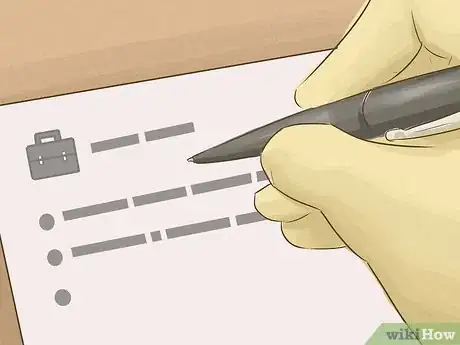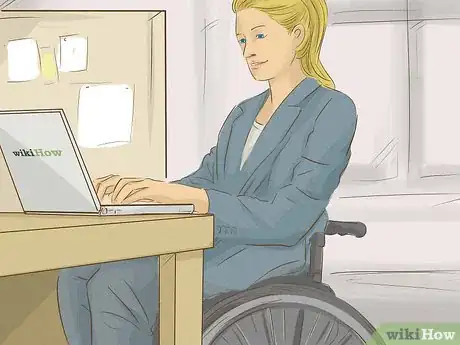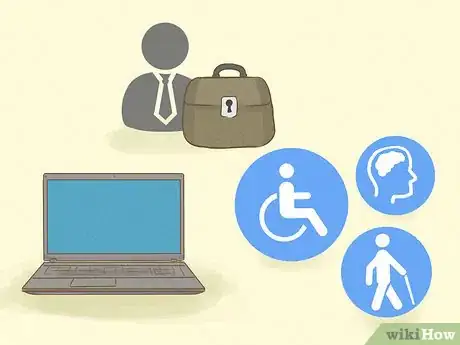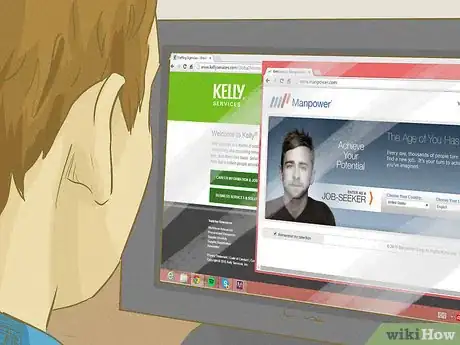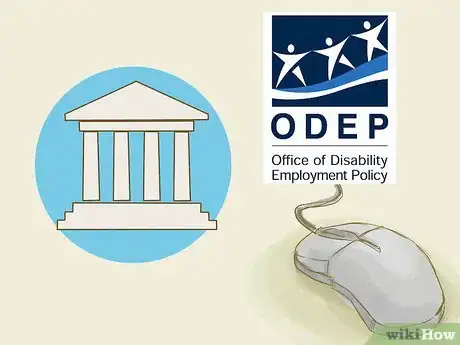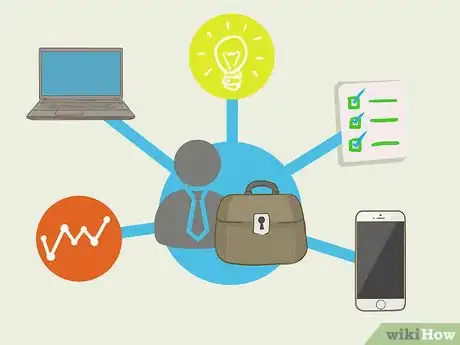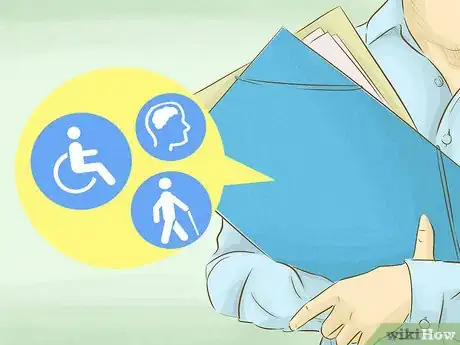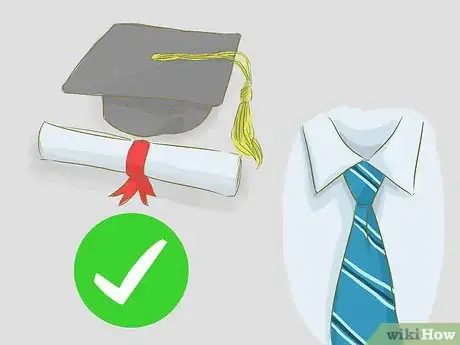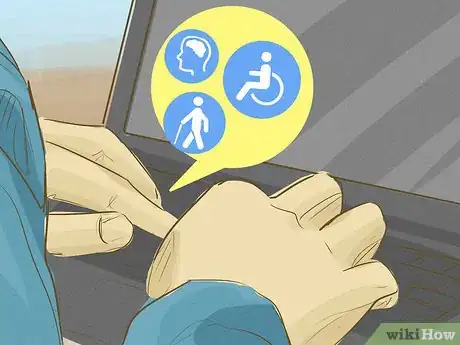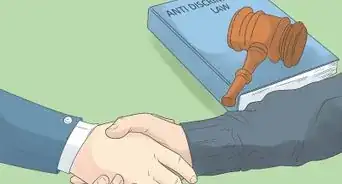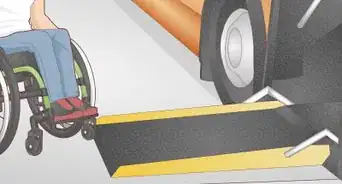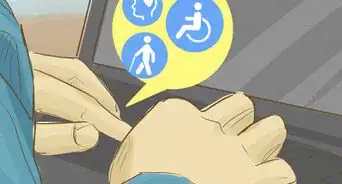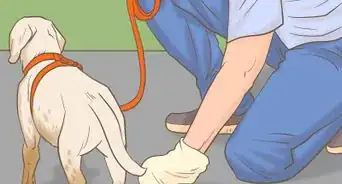This article was co-authored by Amber Rosenberg, PCC. Amber Rosenberg is a Professional Life Coach, Career Coach, and Executive Coach based in the San Francisco Bay Area. As the owner of Pacific Life Coach, she has 20+ years of coaching experience and a background in corporations, tech companies, and nonprofits. Amber trained with the Coaches Training Institute and is a member of the International Coaching Federation (ICF).
There are 20 references cited in this article, which can be found at the bottom of the page.
This article has been viewed 129,374 times.
Having a disability in the workplace often simply means being "differently abled." According to the U.S. government, an individual with a disability is a person who has a physical or mental impairment that substantially limits their major life activities, has a record of their impairment, and is regarded or recognized by the government as having this impairment.[1] In many countries, individuals with disabilities are protected by law, as employers are prohibited from discriminating against applicants with disabilities and often try to focus on hiring individuals with disabilities.[2]
Steps
Assessing Your Abilities and Skills
-
1Make a list of any previous jobs or positions. One of the best ways to determine your abilities and skills is to consider any previous jobs or positions you held as a disabled individual. Many employers will look at the demands of your recent past work and compare them to their requirements and needs in a worker. Think about any work you did for pay or profit and how long you did this work.[3]
- If you are currently working, and make $1,090 US a month, you generally are not considered eligible for disability coverage by the US government.[4]
- If you are not currently working, the hiring agency or employer will send your disability application the Disability Determination Services office. They will then ask doctors about your medical condition, how it limits your activities, and what treatment you are receiving.[5] Your disability will then be confirmed by the government and you will have proof of your disability.[6]
-
2Identify your physical abilities. Consider how your medical condition affects your ability to do certain work-related activities like sitting, standing, walking, lifting, carrying, pushing, and pulling.[7]
- You should also think about how your condition affects your ability to complete manipulative and postural activities like reaching or handling large objects, using your fingers, stooping for objects, balancing objects in your hands, climbing stairs or ladders, and kneeling or crawling.
- For example, if you use a wheelchair, you may not be able to complete certain work-related activities, or you may need assistance when completing these activities. You may also have certain techniques to help you reach for objects or lift objects.
- If you have (or think you may have) a disability, contact your local Department of Vocational Rehabilitation (VR) office. VR can pay for a disability assessment; if you meet the criteria, they can also provide some vocational services and supports, such as uniforms, training, and transportation.[8]
Advertisement -
3Determine your mental skills. Your employer will want to know how well you maintain concentration and attention in a workplace, and your ability to understand, remember, and carry out instructions.[9]
- You will also need to be able to respond appropriately to your supervisors, co-workers, and clients. There may also be changes or adjustments in your work setting during your time at a company or organization. Consider how you cope with change, and shifts in your environment.[10]
- If you have a condition that limits your ability to see, hear, or speak, note this so you are prepared to respond to questions about your mental abilities in an interview with an employer.
-
4Think about factors in the workplace that will negatively affect your condition. Some conditions may make you sensitive to certain environmental conditions, such as temperature extremes or certain substances in the workplace.[11]
- For example, you may have respiratory issues that are aggravated by humidity in the air or dust and fumes. Or you may have hearing issues that are irritated by noise or vibrations from moving machinery. You may also have a discomfort working at heights or with certain odors.
- Identifying your comfort level with these factors will ensure you only pursue work positions that will suit your condition and not harm you in any way.
Looking for Positions
-
1Check out online hiring sites for individuals with a disability. There are several online hiring agencies and services you can access to help you find positions and employment opportunities, including:
- GettingHired.com: An online resource for people with disabilities seeking employment that connects disabled individuals with employers committed to hiring people with disabilities, career services departments and disability advocacy groups.[12]
- Hire Disability Solutions: Provides career services for people with disabilities, veterans, their family members, and others who face challenges in their lives.[13]
- ABILITY Jobs: This site has an extensive database of employers for job seekers with disabilities, and a resume bank where employers can seek talented people with disabilities looking for work.
- Your local VR office can refer you to specific providers of supported employment and other vocational services in your area. If the closest VR office is in another city, VR may provide outreach to your area.[14]
- If you have an intellectual or developmental disability (IDD), contact your local IDD agency. These agencies may provide some form of customized employment or supported employment.
- Contact the Federal Development Disabilities Administration if you aren't sure where your local agency is—local service agencies have different names and are often combined with other providers. Your state agency oversees these local programs and can give you specific contacts in your areas.[15]
-
2
-
3Search government programs for employment. The Office of Disability Employment Policy (ODEP) does not award grants to individuals with disabilities.[18] But there are several helpful government programs and resources for disabled individuals seeking employment.
- USAJOBS.com is a great resource for individuals with disabilities looking for employment through the government.[19]
- The US government also runs a program called Selective Placement that give federal agencies incentives to hire individuals with disabilities. Qualified applicants can be placed in federal agency jobs without going through the competitive placement process.[20]
- The Workforce Recruitment Program,[21] co-sponsored by the Department of Labor's Office of Disability Employment Policy and the Department of Defense, connects postsecondary students and recent graduates with disabilities with positions in the federal government.
- The Pathways Program[22] provides employment opportunities and internships for students and recent graduates, including those with disabilities, in the federal government.
-
4Think about working from home. Working from home can be a useful option for individuals who have difficulty with transportation, long work hours, or who need to maintain specific work schedules.
- Positions like online tech support, quality control, and over the phone customer support are all potential at home careers. Be wary of online scams advertising high paying work from home opportunities. Look for an employment network (EN) in your area to start searching for legitimate jobs for people with disabilities.[23]
- There are several programs and non-profits that look for telecommuting positions for individuals with disabilities.
-
5Consider self employment. Some individuals with disabilities find starting their own business or working for themselves is the most flexible way to generate income and maintain long term employment. If you are thinking about starting your own business, look at entrepreneurship resources online, specifically those that focus on small business owners with disabilities.[24]
- You can also complete a self-employment assessment to determine if you have the skills necessary to start your own business.[25]
Filling Out the Application Form
-
1Obtain proof of your disability. In the US, private employers with at least 15 employees must follow the American Disabilities Act, and cannot discriminate against a “qualified worker with a disability”. The ADA also specifies what counts as a disability, and how these disabled workers are protected by law. Most employers will require proof of your disability and coverage under the ADA. This can be in the form of a simple letter stating you have a disability from your doctor, a licensed medical professional, a licensed rehabilitation professional, or any entity that issues or provides disability benefits.
- The letter does not need to detail your medical history or your need for an accommodation in the workplace.
-
2Look at the job's education and experience requirements. Though the ADA law prohibits an employer from discriminating against you based on your disability, it doesn't require the employer to lower her hiring standards.[26]
- You will need to meet the same education and experience requirements as the other applicants, unless the requirements are discriminatory. For example, they may specify no applicants with disabilities or less hours or pay for individuals with a disability.
-
3Consider the job's duties and the employer's expectations for the position. Look at the job description or list of skills required for the position. You should make sure you can do the basic job duties that are necessary for the position, with or without a reasonable accommodation. Under law, your employer should be able to provide any reasonable accommodations you require to complete the job.[27]
- Don't worry if you may not be able to do nonessential functions, for example, if you are applying to be an office receptionist, you will rarely need to lift 25-pound boxes of paper. As long as you can perform the essential functions, you are protected from discrimination.
-
4Think about if the job fulfills your financial needs. A big consideration should be if the job fulfills your financial obligations as an individual with disabilities that may require physical therapy, medication, or other medical needs. Some employers may specify an hourly or salary wage for the position as part of the job description.
- You can also search for a salary estimate on salary.com.[28] This site takes the job, location, and cost of living for a region to provide a report on salary expectations.
- Once you have an expected salary estimate, compare this amount with your yearly budget. Confirm the position will fulfill your financial needs.
-
5Decide when you are going to discuss your disability with the employer. Disclosure, or sharing information about your disability with others is a personal decision that individuals must make for themselves. You are not required by law to disclose your disability on your application or during the job interview.
- The only appropriate time to disclose your disability on an application is if the employer is actively recruiting employees with disabilities. You can note this by the Affirmative Action statements on the application form.
- During your interview, an interviewer cannot ask you questions about your disability that are not relevant to the job responsibilities. The interviewer should only ask you questions about your qualifications and how you can perform the essential functions of the job.
- There are risks to disclosing your disability to a potential employer at any point of the hiring process. But most disability specialist recommend that applicants disclose their disability after the job offer. This gives you time to learn about the job and to prove yourself to your new employer.
-
6Note any reasonable accommodations you might need. Employers are required to provide reasonable accommodations to qualified applicants and employees with disabilities. Types of accommodations can include:
- Assistance during an interview or any training sessions
- Modifications of positions responsibilities or the work environment
- Opportunities to telework or telecommute
- Other adjustments to allow you to enjoy the benefits of employment
- To receive accommodations at work or during the application process, you need to disclose your disability and share it with the employer. They should then take the necessary steps to meet these accommodations once you are employed.
-
7Follow up with the employer a week after you have handed in the application. Once you submit your application, you should follow up with an email or a phone call to check on the status of your application. Try to speak directly with the employer or with a Human Resources representative about your application.
References
- ↑ http://www.eeoc.gov/eeoc/publications/fs-ada.cfm
- ↑ http://www.nolo.com/legal-encyclopedia/getting-hired-with-disability-30136.html
- ↑ http://www.ssa.gov/disability/step4and5.htm#a0=1
- ↑ http://www.ssa.gov/planners/disability/dqualify5.html#a0=0
- ↑ http://www.ssa.gov/planners/disability/dqualify5.html#a0=0
- ↑ http://www.ssa.gov/disability/step4and5.htm#a0=4&a1=5&sb=1
- ↑ http://www.ssa.gov/disability/step4and5.htm#a0=0
- ↑ Amber Rosenberg, PCC. Pacific Life Coach. Expert Interview. 8 March 2022.
- ↑ http://www.ssa.gov/disability/step4and5.htm#a0=0
- ↑ http://www.ssa.gov/disability/step4and5.htm#a0=0
- ↑ http://www.ssa.gov/disability/step4and5.htm#a0=0
- ↑ http://www.gettinghired.com/
- ↑ http://hireds.com/
- ↑ Amber Rosenberg, PCC. Pacific Life Coach. Expert Interview. 8 March 2022.
- ↑ Amber Rosenberg, PCC. Pacific Life Coach. Expert Interview. 8 March 2022.
- ↑ http://www.manpower.com/
- ↑ http://www.kellyservices.us
- ↑ http://www.dol.gov/odep/faqs/individuals.htm#9
- ↑ https://www.usajobs.gov/
- ↑ https://www.opm.gov/policy-data-oversight/disability-employment/hiring/#url=Schedule-A-Hiring-Authority
- ↑ http://www.dol.gov/odep/wrp/
- ↑ http://www.opm.gov/policy-data-oversight/hiring-authorities/students-recent-graduates/
- ↑ http://www.chooseworkttw.net/findhelp/
- ↑ http://askjan.org/entre/index.htm
- ↑ http://selfemploymenttraining.ruralinstitute.umt.edu/chapter4.htm
- ↑ http://www.nolo.com/legal-encyclopedia/getting-hired-with-disability-30136.html
- ↑ http://www.nolo.com/legal-encyclopedia/getting-hired-with-disability-30136.html
- ↑ http://www.salary.com/
